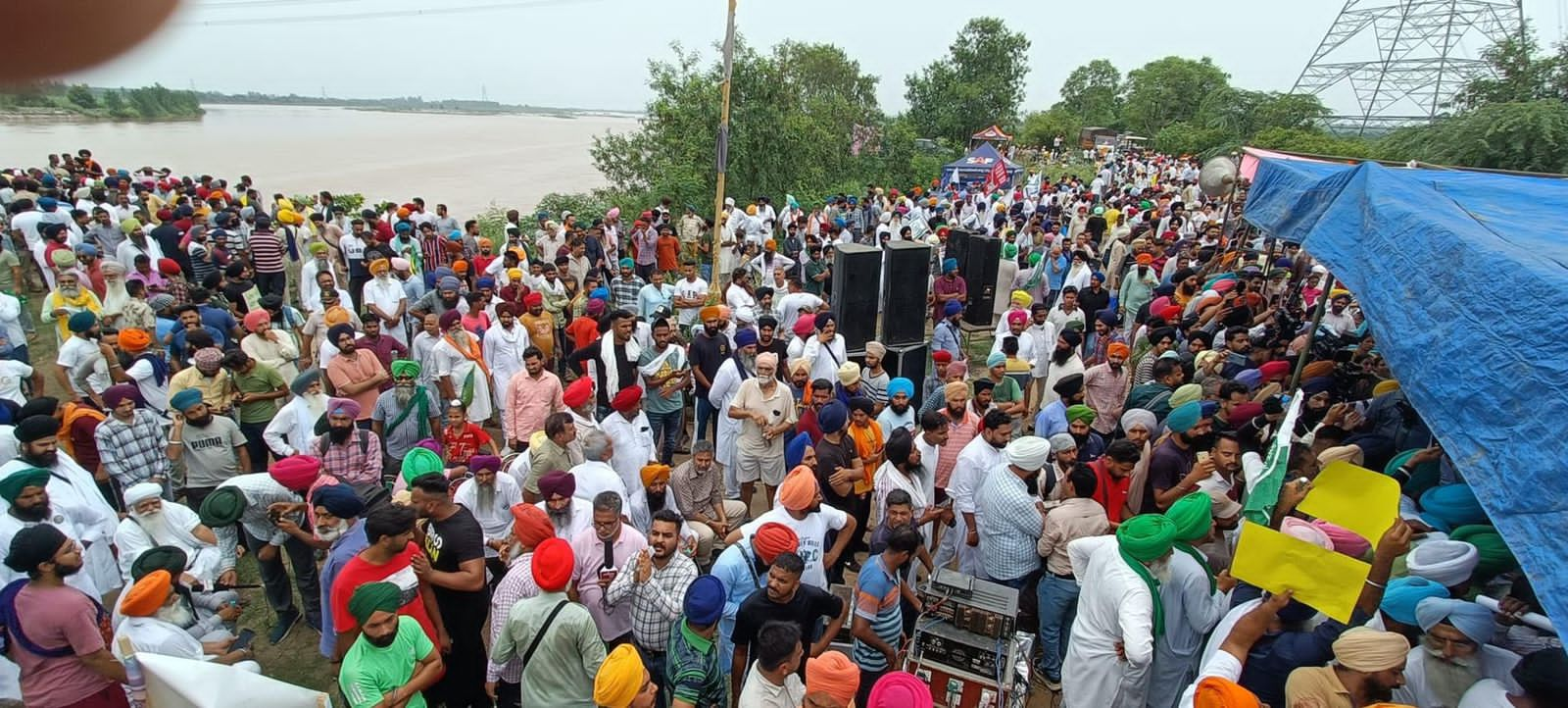
Bhagwant Mann-led AAP government succumbed to pressure after more than 10,000 people, including NGO workers, members of farmers’ unions and others assembled at the project site and threatened to start a movement against the project, reports Aayush Goel
In what has left greens across the state elated and hopeful of revival of environment on state’s priority list, Bhagwant Mann-led AAP government has gone ahead and cancelled the ambitious Textile Park in KoomKalan, Ludhiana.
Approved as part of PM-MITRA scheme, the project was dubbed as the last nail on degrading environmental health of the state and Ludhiana district in particular. The project was to be set up in natural flood plains of Sutlej river bordering one amongst few surviving forest patches of state, the Mattewara forest. Punjab CM Bhagwant Mann had in Vidhan Sabha supported the project. However, it took a u turn and scrapped it when more than 10,000 people – including politicians, members of farmers’ unions, student leaders, and NGO workers – assembled at the project site in Mattewara, vowing to start a permanent movement against the project.
“It was all politically and financially profit driven. The project would have not only disturbed the biodiversity of the protected forest, but would have also led to chemical discharge from factories into the river and make this area a cancer zone like other areas of Punjab. This move gives us hope that now the environment will be considered with importance. We have won this and hopefully be able to eliminate other threats in state and revive dying Satluj. Sutlej is the drinking water source of around 1 crore people who either consume it directly or indirectly.” says Dr Amandeep Singh, an environmentalist and member of Public Action Committee (umbrella body of over 50 NGO’s fighting against the project)
No Industry on River Banks: CM Bhagwant Mann
“I would categorically like to announce that not only in Mattewara but the state government will not allow any industry to come up on the river banks of Punjab to avoid any sort of water pollution. The site for the project was located near Mattewara forest and on the floodplains of Sutlej river but the Amarinder Singh-led government ignored the environmental and ecological costs of the initiative. The project would not only lead to water pollution in the area but also entail felling a considerable number of trees in the vicinity,” said Mann.
Flip Flop by AAP Government: Opposition
While residents and environmentalists lauded the scrapping of the project opposition has termed this flip flop an evidence of a non-competent government.
“The Punjab government‘s announcement of scrapping the Mattewara project shows this Government’s lack of commitment and the inexperience of the CM. The AAP opposed this project during the tenure of the previous government. The party however went on to implement it when it came to power. The CM even defended it in Vidhan Sabha and has now withdrawn it due to public pressure. This constant flip-flop is an embarrassment and shows the lack of vision on the part of AAP for Punjab.” said leader of Opposing Congress leader Pratap Bajwa.
The controversial project
A Mega Integrated Textile Region and Apparel Park, under the PM-MITRA scheme was being undertaken jointly by the Centre and the state government. Initially it was named as Mattewara Textile Park for its proximity to Mattewara forest but after public outrage, the name was changed. As per the Union Ministry of Textiles, this park was to be one amongst seven such parks that would come up across the country with the objective of sustainable industrialisation that does not harm the environment to “meet the United Nations sustainable development goals.” The 957.74 acres of land was acquired so far, falling near the Mattewara forest and on the river Sutlej floodplains. Out of this, 416 acres were allegedly forcefully acquired from the Dalit-majority Sekhowal village despite the Gram Sabha of the village having passed a resolution against it. The acquired land will now be returned.
Mattewara forest and nearby site to be converted to Biodiversity park.
The now cancelled project site touches Mattewara forest from two sides and river Sutlej on one side. Spread over 2,300 acres, the forest is the sole lung of Ludhiana district which is one amongst top polluted districts in India. Punjab is among the states with poorest forest cover with just 3.7 percent of its land under forest. It has minimal untouched forest patches scattered across Punjab and Mattewara is one amongst them. The forest is not just rich in flora but also houses several animal and avian species including Peacocks, Sambhar, Antelopes (nilgai), Monkeys, Deers etc.
The government has now announced to set up a biodiversity park which would also include government land diverted for the textile park earlier.
Sutlej Pollution Threat
Not just the forest but environmentalists fear of toxic discharges in Sutlej post setting up of any projects on Sutlej banks. The river is popularly known as the dead river in Punjab owing to high levels of pollution. According to records, the state was disposing of around 2000 kilolitres of wastewater per day in the river in year 2021, apart from the enormous amount of industrial effluents mainly via Buddha Nullah in Ludhiana. There are 2423 industries in the river Sutlej catchment area, which either directly or indirectly release their trade effluent into Sutlej. Buddha Nala is the district’s oldest rivulet and one of key channels of Sutlej pollution. The water in the nullah is rich in toxins and merges with Sutlej making it highly polluted. The polluted water has been recognised as a key reason behind the high number of cancer patients across the river course which runs across the Malwa region till Rajasthan. The water is being used directly or indirectly by many for crop irrigation, household works, and for drinking.
“Industries set up on the banks of Staluj and discharging effluents in it directly or indirectly are killing the river. Thousands of villagers still depend on Sutlej for drinking water and other needs and we cannot have one more polluting project on its banks. The government decision is encouraging and we will now fight to get other polluting units also moved out,” says Bhavjit Singh, activist and member of the Public Action Committee (PAC).
Alternate Site at Kandi area a Solution?
The opposition headed by Congress leader Pratap Singh Bajwa has suggested that this project, if vital to the state’s economy, can be shifted to Kandi area where there is more environmental stamina to recover any loss and needs economic attention.
“We understand the fight between development and the environment. Yes the project can be an economic booster but the current site is not the place. The fragile ecological balance will collapse. This can be set up at a place where environmental replenishment is easy and there is a need for economic development. We suggest Kandi area,” said Bajwa. It may be noted that Shivalik hills are situated along the eastern boundary of Punjab and this sub-mountainous or semi-hilly area is locally called as Kandi area. This area is spread across around 10 kilometre belt along the border with Himachal Pradesh. Most parts of Hoshiarpur and Pathankot districts and some parts of Roopngar, NawanShahr and Mohali districts lie in Kandi area of Punjab.













